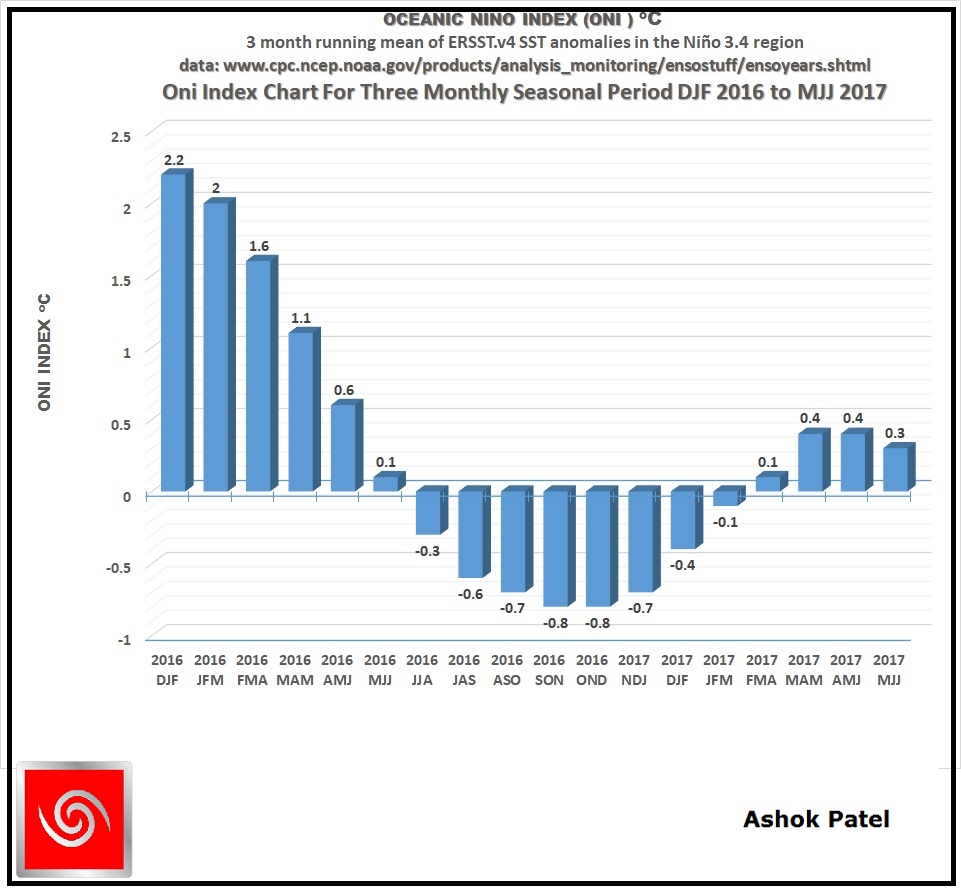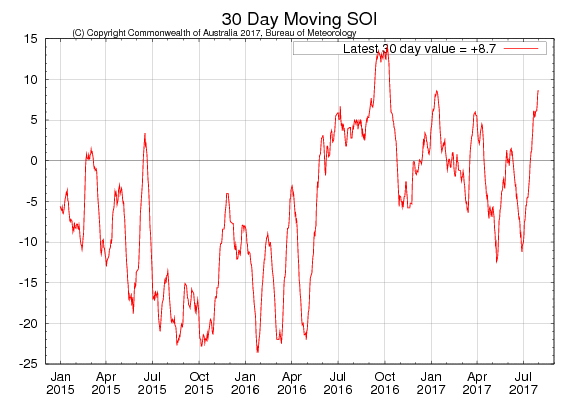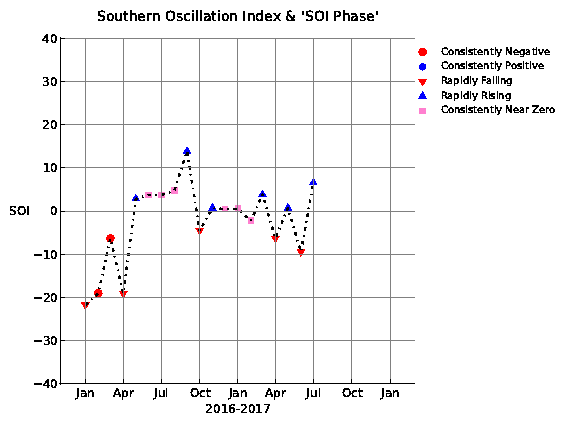ENSO Status on 4th August 2017
The ONI is based on SST departures from average in the Niño 3.4 region, and is a principal measure for monitoring, assessing, and predicting ENSO. Defined as the three-month running-mean SST departures in the Niño 3.4 region. Departures are based on a set of improved homogeneous historical SST analyses (Extended Reconstructed SST – ERSST.v4). The SST reconstruction methodology is described in Huang et al., 2015, J. Climate, vol. 28, 911-930.
CPC uses current Climatology based on 1986-2015 which has been changed late last year from base years 1981-2010. Explanation about Climatology base years change is given here.
NOAA Operational Definitions for El Niño and La Niña, El Niño: characterized by a positive ONI greater than or equal to +0.5ºC. La Niña: characterized by a negative ONI less than or equal to -0.5ºC. By historical standards, to be classified as a full-fledged El Niño or La Niña episode, these thresholds must be exceeded for a period of at least 5 consecutive overlapping 3-month seasons.
CPC considers El Niño or La Niña conditions to occur when the monthly Niño3.4 OISST departures meet or exceed +/- 0.5ºC along with consistent atmospheric features. These anomalies must also be forecast to persist for 3 consecutive months.
Short lived La Nina ended with last 3-monthly season as NDJ 2017. Subsequently, Enso neutral conditions have prevailed thereafter.
ONI Index for DJF 2017 was -0.4ºC, JFM 2017 was -0.2ºC, FMA 2017 was +0.1ºC, MAM was +0.4ºC, AMJ was +0.4ºC and now the last ONI Index MJJ is +0.3ºC, hence the Nino 3.4 Region of Pacific Ocean continues to remain in ENSO Neutral zone.
Latest Oceanic Nino Index (ONI) Graph Showing Enso Neutral Event For Last Three 3- Monthly Seasons Ending July 2017
The Table below shows the monthly SST of Nino3.4 Region and the Climate adjusted normal SST and SST anomaly for last two years. Climate Base 1986-2015.
Period Nino3.4 ClimAdjust YR MON Temp.ºC Temp.ºC ANOM ºC 2015 7 28.50 27.37 1.13 2015 8 28.47 27.02 1.45 2015 9 28.62 26.94 1.68 2015 10 28.86 26.91 1.95 2015 11 29.14 26.88 2.25 2015 12 29.04 26.80 2.24 2016 1 28.95 26.61 2.33 2016 2 28.89 26.80 2.09 2016 3 28.86 27.32 1.54 2016 4 28.96 27.86 1.10 2016 5 28.59 27.98 0.60 2016 6 27.81 27.76 0.05 2016 7 26.98 27.37 -0.39 2016 8 26.39 27.02 -0.63 2016 9 26.20 26.94 -0.74 2016 10 26.04 26.91 -0.87 2016 11 25.96 26.88 -0.93 2016 12 26.08 26.80 -0.72 2017 1 26.24 26.61 -0.37 2017 2 26.63 26.80 -0.17 2017 3 27.49 27.32 0.17 2017 4 28.30 27.86 0.44 2017 5 28.54 27.98 0.56 2017 6 27.97 27.76 0.21 2017 7 27.40 27.37 0.03
CPC considers El Niño or La Niña conditions to occur when the monthly Niño3.4 OISST departures meet or exceed +/- 0.5°C along with consistent atmospheric features. These anomalies must also be forecast to persist for 3 consecutive months.
Southern Oscillation Index
As per BOM, Australia:
The 30-day Southern Oscillation Index (SOI) on 30 July was +8.1 (90-day value −0.4). SOI values have generally been within the neutral range since mid-October. However, recently they have shot up and flirting the positive zone.
The latest 30-day Southern Oscillation Index (SOI) on 31st July 2017 is +8.7 which is flirting the positive zone.
Sustained positive values of the SOI above +7 typically indicate La Niña while sustained negative values below −7 typically indicate El Niño. Values between about +7 and −7 generally indicate neutral conditions.
SOI Monthly graph up to July 2017 as per The Long Paddock – Queensland Government.
30 Days average SOI was +6.51 at the end of July 2017 and +8.01 on 2nd August 2017 as per The Long Paddock – Queensland Government.
Summary by: Climate Prediction Center / NCEP Dated 31st July 2017
ENSO Alert System Status: Not Active
ENSO-Neutral conditions are present.*
Equatorial sea surface temperatures (SSTs) are near-to-above average across the central and east-central Pacific Ocean.
ENSO-Neutral is favored (50 to ~55% chance) into the Northern Hemisphere winter 2017-18.*
* Note: These statements are updated once a month (2nd Thursday of each month) in association with the ENSO Diagnostics Discussion, which can be found by clicking here
As per BOM -Australia 1st August 2017
ENSO neutral conditions are likely to persist – ENSO Outlook Inactive:
All eight of the international climate models surveyed by the Bureau indicate that ENSO-neutral conditions are likely to persist until at least the end of 2017
Ashok Patel’s Final Note: Full Fledged El Nino Not Possible During 2017 Using NOAA Criteria.
The current SST of Nino 3.4 region is below +0.5°C at +0.03°C and also the last ONI Index available is MJJ 2017 at +0.3°C which is yet in the Enso Neutral zone. The SST for August is not expected to increase by 1.0°C from the current +0.03°C, hence the ONI Index for JJA 2017 will be < 0.5°C. Even if the ONI index of next Four 3-monthly seasons namely JAS 2017, ASO 2017, SON 2017 & OND 2017 manages to remain equal to or above 0.5°C, yet it will not qualify for a Full fledged El Nino as per NOAA criteria during 2017, since the fifth 3-monthly season required for qualification of El Nino is NDJ 2018 which would be end of 2018 January.
અશોક પટેલ ની નોંધ :
ઓસ્ટ્રેલિયા ની BOM સંસ્થા મુજબ 2017 માં એલ નિનો થવા ની શક્યતા નથી. વર્ષ 2017 દરમિયાન સૈદ્ધાંતિક રીતે પણ હવે વિધિવત એલ નિનો (NOAA, U.S. ના માપ દંડ મુજબ ) શક્ય નથી કારણ કે વિધિવત એલ નિનો ડિક્લેર કરવા માટે ના સળંગ 5 ત્રિમાસિક સીઝન એલ નિનો માપ દંડ પ્રમાણે હોવા જોઈએ. જે થાય તે પહેલા તો વર્ષ 2017 પૂરું થઇ ગયું હશે.



Jay dwarkadhisu
Sorry sir for again same comment
Sir have to sravan mahina na and ma j rah jovani varsad ni
Me agad ni comment ma pan puchelu hatu ke saptembar ma kem all india ma monsoon nabdu pade se sar koi karan to hase j
Phesephik arm ne karne ke biju kai
15 September aaspaas Rajasthan baju thi Chomasu viday letu hoy chhe ame tyar baad kramsh bija bhago mathi.
Pacific (Prashant) saathe kai leva deva nathi.
Sir tarikh 7. 8. Na kachh ni border upar uac thai chhe sachu
tamoye je joyu hoy tevi darek aat mare confirm karvi ?
Confidence rakho aney bedhak je joyu hoy te magaj ma rakho.